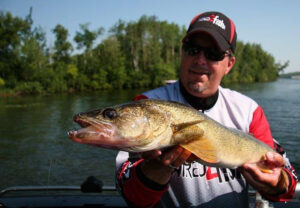Former Professional Walleye Trail professional angler and noted multi-species expert, Scott Glorvigen of Grand Rapids, Minn., frequently uses soft baits during fall. Internally weighted or rigged on a jig, he uses plastics on deep structures, weeds and rivers.
Big baits and erratic tactics trigger reaction hits. Compact ones catch fish hunkered tight to cover, structure or current seams. What follows are Glorvigen’s Top 5 walleye soft baits and proven spots to fish them in fall.
Here are 5 plastics styles he likes for walleyes:
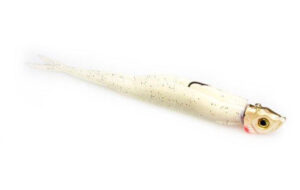
Soft jerkbaits
When walleye are hunting whitefish, ciscoes or other cold-water species near structure, Glorvigen wields a 5- to 7-inch Zoom Super Fluke on a 1/2- to 3/4-ounce Northland Fishing Tackle Mimic Minnow jig head. Here’s the scenario: As summer wanes in deep, natural lakes, these cold-water fish move from oxygen-depleted deep basins to warmer, oxygen-rich areas near or above the thermocline, usually around 28 to 35 feet.
“The warm water weakens cold-water species, like whitefish and ciscoes. Consequently, they start to struggle and big predator fish take advantage of them,” Glorvigen said. “Walleye aren’t chasing fish. They’re looking for struggling fish that are erratic in how they’re swimming. Throwing big plastics, like a Zoom Super Fluke, mimics the struggling, kicking forage base that they’re feeding on.”
Line details are critical for this presentation. Glorvigen uses 10-pound Berkley Fireline Crystal. Its no-stretch trait is key to get a fluke to dance erratically. The white superline also acts as a strike indicator. Just as important is the 18-inch leader of 10- or 12-pound Berkley Trilene 100% Professional Grade Fluorocarbon. The fluoro’s stiffness prevents a fluke from rolling backwards, and tangling in the braid when the jig’s aggressively snapped. Fluorocarbon’s durability is an added bonus and can prevent bite-offs from incidental northern pike catches.
- Junction points “The ultimate piece of structure for this tactic is a deep underwater point going into the deepest basin of the lake because this is where the forage base sets up in summer. Stair-stepping down into the deep water is often best. Steps mean different bottom compositions, different types of rock and different hiding places for predator fish. In stained water he looks for structures topping out between 10 and 15 feet. In clear water it’s 15 to 20 feet.
- Erratic tactics “I fish a fluke aggressively and quickly. I snap it and pop it to mimic the erratic swimming action of dying, deep-water forage,” Glorvigen said. “Plastics need to be fished aggressively to get that reactionary strike.”
- Cutting jigs “Wedge or arrow head jigs are the best for this tactic. The Mimic Minnow head is like a skate blade. It cuts and darts back and forth.”
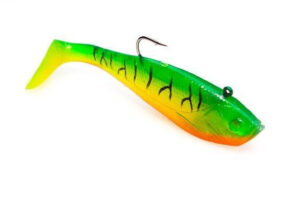
Internally weighted swimbaits
Healthy weedlines are other walleye autumn hotspots. Glorvigen favors a 5- to 6-inch internally weighted swimbait for these zones.
“Walleye relate to the perch or bluegill population living in the weeds. Using a bulky, wide bait, like a Storm WildEye Swim Shad, replicates the profile of these forage species,” said Glorvigen.
- Fan cast, then fine tune “Typically, I start casting perpendicular to a weed line, casting out, trying to figure out where fish are located. If walleye are at the base of weeds, I’ll then either cast parallel to the weed edge or cast on a 45-degree angle, so I can keep the bait in the strike zone through the majority of the retrieve,” said Glorvigen.
- Retrieve tricks “The Swim Shad has more of a natural fall, but I’ll pop it and snap it up from time to time. It’s more of an up-down, stop-and-fall retrieve. I want that bait to be erratic to get that reactionary strike,” said Glorvigen.
- More time near bottom “With the internal weight and being a bigger bait, I can cast a Swim Shad out and keep it in the strike zone along bottom longer during the retrieve,” said Glorvigen. “I can’t do that with a light plastic.”
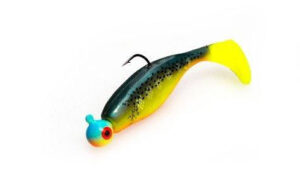
Shad baits
A 3- to 4-inch shad, or pogy, bait rigged on a 1/4- to 3/8-ounce round jig head is another of Glorvigen’s autumn walleye weapons. Sample baits include the Mister Twister Sassy Shad and the new Northland Fishing Tackle Impulse Paddle Shad.
Outside weed edges, flats and the 4 to 10 foot food shelf are areas he fishes with this jig. Glorvigen predominantly retrieves the shad bait like a crankbait. But, the sinking jig is more versatile and is used to cover a wider range of depths per cast.
“I vary retrieves and vary action. Most of the time it’s like a roller coaster. I may start to bring rod tip up, then let rod tip fall when I’m reeling and swimming it back to boat. This gives me a good opportunity to work the water column,” Glorvigen said.
Glorvigen’s Tackle Choices for Fall Plastics
- Rod and Reel Combo 1: Fenwick 6’6″ Elite Tech Walleye, Medium Power, Fast Action with Mitchell 300 Spinning Reel
- Rod and Reel Combo 2: St. Croix 7′ Avid Medium Power, Fast Action with Lew’s Tournament High Speed Speed Spin
- Line: 10-pound Berkley Fireline Crystal or Northland Fishing Tackle Bionic Walleye Braid
- Leader: 18-inches of 8- to 12-pound test Berkley Trilene 100% Fluorocarbon Professional Grade
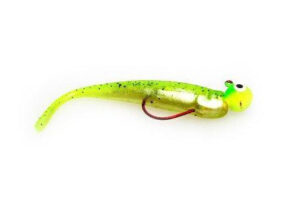
Finesse minnows
On some of Glorvigen’s home lakes, healthy coontail becomes prime walleye habitat in September after broad-leaf cabbage dies-off. He picks apart the coontail canopy using short casts or vertically jigging a 3-inch finesse minnow. The plastic is rigged weedless on a long-shank, 1/4- or 3/8-ounce mushroom or ball head jig. Using a rattle jig or inserting a rattle chamber into the plastic adds another sensory dimension to the presentation, and helps walleye locate the bait.
“The neat thing with a Berkley PowerBait Twitchtail Minnow or a Northland Smelt Minnow is I can rig it weedless and probe weeds for fish. I can’t go in with a Super Fluke. I’d get hung up all the time. But, with a smaller bait I can get in the weeds and down to bottom. Then I can twitch it and dance it in place like a shaky head jig, giving fish time to feel it, smell it, locate it and bite it,” said Glorvigen.
“I typically tie direct with either 10-pound Berkley Fireline or Northland Bionic Walleye Braid. I use braid for feel, but the best thing about it is when I hook a big fish, the braid cuts through the weeds like a sickle bar going through a hay field. This gives me the advantage and helps get the walleye up and out of the weeds,” said Glorvigen.
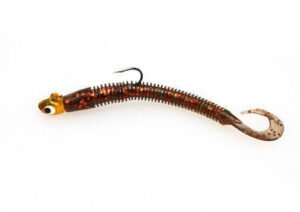
Ring worms
For shallow rivers, Glorvigen uses a dark colored, 4-inch Berkley PowerBait Rib Worm or 4-inch Northland Fishing Tackle Impulse Ringworm. Three-inch twister tail grubs are sometimes used for a more compact offering. Green pumpkin and crawdad match the darker minnow and crayfish forage base of the stained rivers he fishes. A 1/8- to 1/4-ounce jig is selected to match current speed.
“I want the jig to move at the same speed as a dead minnow drifting down the current,” Glorvigen said. “A lot of times in a river, fish are in ambush mode and set up on a current break. If they see something and it looks natural, they’ll set up on it and eat it.”
- Why ringworms? “The worm’s rings traps air. This keeps the tail floating up and the bait off bottom. It improves the bait’s action, and allows fish to feel it coming and target it.
- River hotspots “Fish these plastics in areas on rivers that create a change in current dynamics, like a neck down, wing dams and the confluence of a tributary. Turbulent water below a power dam is also prime water, but remember to heed all safety warnings when fishing these areas.
- Natural drift “I cast the jig upstream on a 45-degree angle. Then picking up the slack in the line, I drift and skip the bait as it goes along bottom until it swings to a 45-degree angle downstream.”
Plastics deserve water time in the fall. Try Glorvigen’s top 5 soft plastics for this season, and you’ll haul-in more chunky walleye from autumn’s cool waters.
